PHILIPPINES — On November 8, Typhoon Haiyan/Yolanda* slammed into the Philippines islands leaving catastrophic destruction in its wake. According to the BBC, the Philippine government is calling Haiyan/Yolanda one of the worst storms on record with an official death toll of 3631. As reported on NPR “U.S. Navy/Air Force’s Joint Typhoon Warning Center, Haiyan produced sustained wind speeds of around 190 or 195 mph at its peak and… gusts up to 230 mph, which is as fast as a speeding race car.”
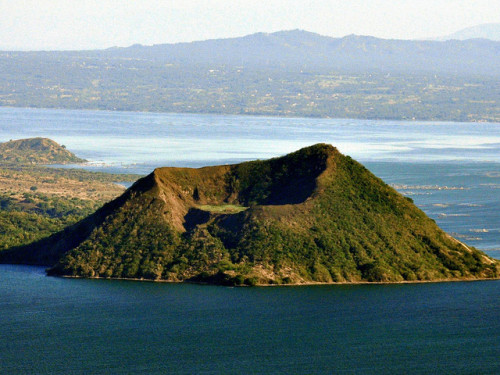
Photo Courtesy of Flickr’s therealbrute
Because of its location the Philippines is accustomed to strong storms – even typhoons that would equate to a category 4 or 5 hurricane in the United States. The country is an archipelago made up of over 7,000 islands which sits in a highly vulnerable geographic location. To the north rests Taiwan; to the South, Indonesia and to the West, Vietnam. In the east, there is nothing but warm Pacific Ocean making the Philippines a very easy target for storms.
Historically speaking this location also made the Philippines a popular stopping point for maritime travelers. Waves of ancient peoples made their home on these islands as they navigated the South Seas; including the Austronesian tribes and those from the ancient Hindu and early Islamic worlds. In the 16th century Spain colonized the archipelago, naming it after King Philip II (1527-1568.) The Spanish remained in control until the Spanish-American war in 1898. Spain ceded the Philippines to United States who finally granted it sovereignty in 1946.
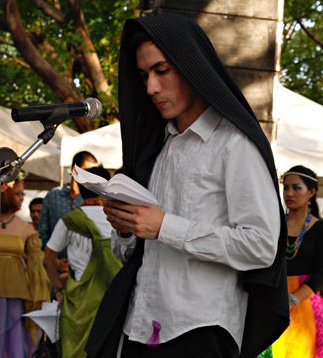
Aldrin, Hellenist in Manila
Due to centuries of foreign influence, modern Filipino culture is richly-layered. Most readily apparent is the Spanish influence – particularly in religious practice. With the Spanish colonists came Catholic missionaries who converted the indigenous population. Today 90% of all Filipinos are Catholic. The remaining 10% identify with a few minority faiths such as Muslim, Hindu, Jewish, Buddhist and others. As noted by Aldrin, a blogger and Hellenist living in Manila,“Unfortunately few things about the pre-colonial religions of the Philippines were written down.”
Despite this strong Catholic current, there is a growing Pagan population. In July 2013, the Pagan Federation International opened the first Filipino branch in Cebu City. Ariel Lim, a solitary eclectic Wiccan, is its national coordinator. As far as Ariel can tell, most Filipino Pagans identify as eclectic Wiccans or general “Neo-Pagans.” This term is commonly used to distinguish modern religious practice from the ancient indigenous population who are referred to as “pagans.” Ariel says:
Ariel Lim, National Coordinator for PFI in the Philippines.
Paganism in our country is very beautiful especially [paired] with the indigenous paganism [of] our ancestors. Many people carry the influence of indigenous healers and are incorporating it in their practices… We are trying to dig it up and hopefully find a living [aspect] for the Craft.
Aldrin agreed adding:
Although a Hellenist, I place great importance on the preservation and continuation of our indigenous paganisms… There’s always been a very magical culture that’s persisted in Filipino society despite Catholicism.
He attributes this natural mysticism to the growing interest in Neo-Paganism, particularly Wicca.
This natural mysticism is particularly evident on the island of Siquijor – often referred to as Witchcraft Island. Every year the island holds a Folk Healing Festival during which visitors can watch local healers and herbalists perform their Craft. These folk healers, however, are not Neo-Pagans; nor are they the lost indigenous tribes. They are Catholic. Interestingly they see no inherent conflict between their Craft and their religious faith. In fact Catholic imagery and mythology are often incorporated into their magical workings, natural mysticism and healing mechanisms.
The combining of religious and esoteric systems is not at all uncommon in the Philippines. Gino Paradela y Pastoriza, a Buddhist, PFI’s researcher and an anthropology student, says, “Filipino Neo-Paganism is heavily influenced by Catholic symbolism and theology. [Filipino Pagans]…see no problem with syncretism.” This lends a unique quality to Filipino Paganism. As an example, he notes one particularly unusual practice based, on what he called, an “animistic-catholic mythological pantheon.”
Sometimes the use of Catholic imagery is not religious syncretism and merely a way to mask Neo-Pagan beliefs. Despite the cultural acceptance of magic and the Filipino secular-based constitution supporting religious freedom, there is still an underlying Catholic-born fear of the occult and witchcraft. Ariel notes, “There have been cases of accused witches being killed in some areas of the Philippines…” However, these attacks are not directed at Neo-Pagans but at folk healers who have used their Craft for illegal purposes.
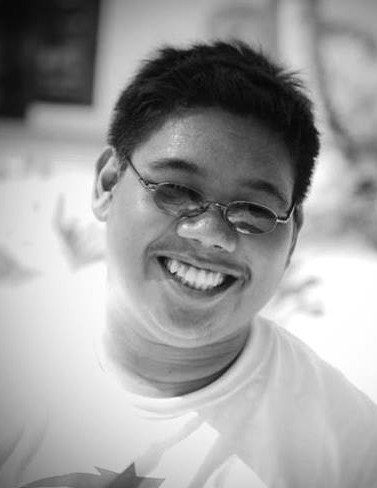
Gino Pradela, PFI Researcher
Regardless of this distinction, Gino says, “Hearing the word Pagan would definitely raise some doubts [in people’s minds.] Murmur, an eclectic Neo-Pagan and a member of both Arn nDraiocht Fein and the Order of Bards, Ovates and Druids, explains that Neo-Pagans are considered “weirdos.” While harassment is rare, Ariel has heard reports of Neo-Pagans being bothered by “die-hard Christians and faith healers.”
Consequently Neo-Pagans remain a “silent minority.” Most practice as solitaries and do all shopping, socializing and learning over the internet. There are very few, if any, covens, festivals or mentors and limited access to books. Aldrin “thanks the Gods” for technology which has allowed him to connect to other Hellenists and grow his personal spiritual practice.
There is another major obstacle for Filipino Pagans – one that brings us back to the origins of Filipino culture. Because the country is an archipelago, attending events, big or small, requires complicated travel. All four Filipino men interviewed mentioned this particular issue as a hindrance to the growth of Filipino Pagan solidarity and networking. Aldrin celebrates Pagan-inclusion in local interfaith events but he “wishes [Pagans[ had something of our own.”

Aldrin may get his wish as the tides seem to be changing. In 2010 Manila had a Pagan Pride Day in coordination with the annual Earthdance festival. The newly formed PFI is a welcomed part of PEACE (Preachers and Educators Assembly of Cebu) and is doing extensive public advocacy work and interfaith outreach. Ariel says, “We have started to tap into the public…The people are slowly accepting the existence of Pagans.”
Most recently PFI took very aggressive action to help Typhoon victims. Ariel recalls:
Hours before the typhoon, I went into a deep meditation focused on protecting the house and the neighborhood…. We prayed to the Gods to protect us and minimize damage…. When I came down in the morning, the typhoon was gone and we did not get much damage….I was thinking everyone was fine until I saw the news…PFI immediately organized a relief operation and started to contact people. PFI wanted to organize the mission and personally hand down the goods to victims. The best way we can help is make sure [victims] could eat every day until they are ready to be on their own. My biggest concern was immediate relief. [Ariel’s full story here]
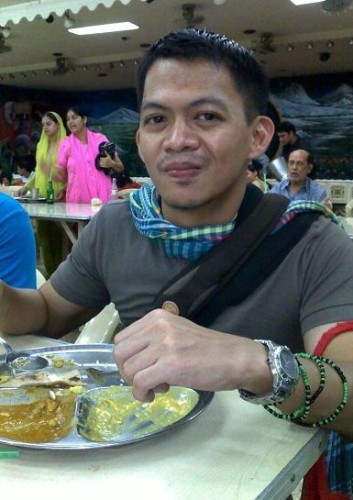
Murmur, an eclectic Pagan, ADF and OBOD member
Like Ariel; Aldrin, Murmur, and Gino live in areas that were not hard hit. As a result they were surprised at the catastrophic level of damage. Gino said, “The aftermath is the worst that I have ever seen. People are in desperate need of food, water and medicine.” Aldrin notes, “I’ve only been speechless at the devastation and desperation that our countrymen down south experienced and continue to experience. It is grief that cannot be summed up in words.” Murmur laments:
There was shock, followed by grief, and what we have right now is a mix of gratitude [for] all the help pouring in and anger at our own government. What isn’t said much in the international news is that we also had two freakish, record-breaking monsoon rains in just a year, I see this clearly a sign of climate change and it really saddens me that my country has to suffer all of this. I wish there were more concrete steps to work against climate change on a global level.
Scientists agree with Murmur’s observations.
As for today, the needs continue as the country rebuilds from last week’s storm. Before ending the interview, Aldrin added, “All the help that’s been pouring in from around the world has been uplifting and we couldn’t thank you enough.” His sentiment was strongly echoed by the other three men. “Thank You.”
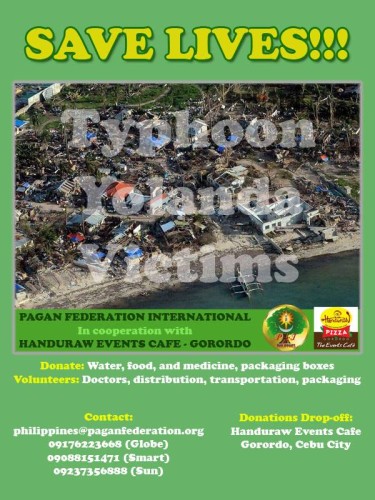
* Typhoon Haiyan was called Yolanda by Philippine Meteorological officials.
The Wild Hunt is not responsible for links to external content.
To join a conversation on this post:
Visit our The Wild Hunt subreddit! Point your favorite browser to https://www.reddit.com/r/The_Wild_Hunt_News/, then click “JOIN”. Make sure to click the bell, too, to be notified of new articles posted to our subreddit.

I really appreciate these features on the lives and concerns of Pagans from around the world. May the Gods bless and watch over Their own in the Philippines during these terrible times. I’m doing what I can from here, but it just never feels like enough :/
Aww, don’t think that way. Any sort of help is greatly appreciated!
May God watch over one of the most Christian and Catholic Countries in the world.
I sent a donation via the Disasters Emergency Committee, and plan to send more next month. I hope all Filipinos, whatever their religious affiliation, will soon be back up on their feet.
I just wanted to leave a message to thank you for that. Really, it means a lot to us as a country.
Thank you, Aldrin. And best wishes with your path. I assume you are the Aldrin mentioned in the article – I hope you find some fellow Hellenists. And I am glad you and your family are OK.
Yes, same guy. And thank you for the well wishes! There’s at least one other Hellenist I know, but he lives farther up north. My cultus revolves around my family and the local community, really, so it’s okay. 🙂
Ah, that’s good. And having the internet is such a help 🙂